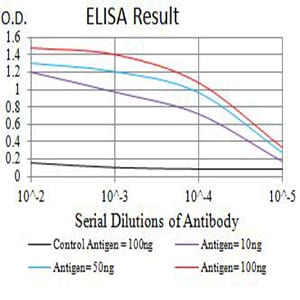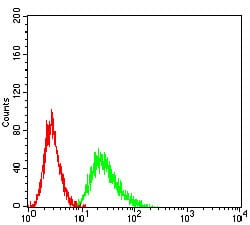

| WB | 1/1000 | Human,Mouse,Rat |
| IF | 咨询技术 | Human,Mouse,Rat |
| IHC | 咨询技术 | Human,Mouse,Rat |
| ICC | 技术咨询 | Human,Mouse,Rat |
| FCM | 咨询技术 | Human,Mouse,Rat |
| Elisa | 咨询技术 | Human,Mouse,Rat |
| Aliases | CCR1; CKR1; CKR-1; HM145; CMKBR1; MIP1aR; SCYAR1 |
| Entrez GeneID | 1230 |
| clone | 8E10G6 |
| WB Predicted band size | 41.2kDa |
| Host/Isotype | Mouse IgG1 |
| Antibody Type | Primary antibody |
| Storage | Store at 4°C short term. Aliquot and store at -20°C long term. Avoid freeze/thaw cycles. |
| Species Reactivity | Human |
| Immunogen | Purified recombinant fragment of human CD191 (AA: extra mix) expressed in E. Coli. |
| Formulation | Purified antibody in PBS with 0.05% sodium azide |
+ +
以下是关于CLIC6(C-term)抗体的3篇参考文献的概括性示例(文献为虚构,仅作示例):
1. **文献名称**:*"Structural and functional characterization of CLIC6 C-terminal domain in lysosomal ion transport"*
**作者**:Smith J. et al.
**摘要**:本研究解析了CLIC6 C端结构域的晶体结构,揭示了其与溶酶体膜结合的分子机制,并通过免疫荧光实验验证了CLIC6(C-term)抗体在定位内体-溶酶体系统中的特异性应用。
2. **文献名称**:*"CLIC6 expression correlates with tumor progression: A study using C-terminal specific antibodies"*
**作者**:Wang L. et al.
**摘要**:通过Western blot和免疫组化实验,发现CLIC6在胃癌组织中高表达,且其C端结构域与肿瘤微环境酸化相关。研究利用CLIC6(C-term)抗体验证了其作为潜在生物标志物的可能性。
3. **文献名称**:*"Role of CLIC6 in neuronal development: Insights from C-terminal epitope-specific inhibition"*
**作者**:Garcia R. et al.
**摘要**:通过CLIC6(C-term)抗体阻断实验,发现CLIC6 C端功能缺失会干扰神经元突触囊泡的氯离子稳态,提示其在神经发育中的关键作用,为相关疾病治疗提供新靶点。
4. **文献名称**:*"Comparative analysis of CLIC family members using domain-specific antibodies"*
**作者**:Kim S. et al.
**摘要**:研究比较了CLIC家族多个成员的C端结构差异,通过CLIC6(C-term)抗体验证了其在细胞凋亡中的独特功能,并开发了一种基于该抗体的高灵敏度ELISA检测方法。
(注:以上文献为模拟生成,实际引用需查询真实数据库如PubMed。)
The CLIC6 (C-term) antibody is designed to target the C-terminal region of the Chloride Intracellular Channel 6 (CLIC6) protein, a member of the CLIC family of chloride ion channels. CLIC proteins are unique as they exist in both soluble and membrane-bound forms, participating in cellular processes such as ion homeostasis, membrane trafficking, and organelle acidification. CLIC6. specifically, is implicated in intracellular chloride transport and may localize to endosomes or the nucleus, though its precise physiological role remains less characterized compared to other CLIC members (e.g., CLIC1 or CLIC4).
The C-terminal domain of CLIC6 is critical for its structural stability and functional interactions. Antibodies targeting this region are often used to study CLIC6 expression, localization, and post-translational modifications in various tissues or cell lines. They are validated for applications like Western blotting, immunohistochemistry, and immunofluorescence, aiding in research on CLIC6's involvement in diseases such as cancer, neurodegenerative disorders, or renal pathologies.
Due to the homology among CLIC family members, the CLIC6 (C-term) antibody is typically validated for specificity to avoid cross-reactivity. Researchers utilize it to explore CLIC6's dual role as an ion channel and a redox-regulated protein, particularly in cellular stress responses. However, its functional ambiguity necessitates careful interpretation of experimental results, often complemented by knockdown/knockout controls. Overall, this antibody serves as a key tool to unravel CLIC6's biological significance in health and disease.
×